Ask A Researcher
August 2024
Give it your best shot: Preventing illness with routine immunizations
National Immunization Awareness Month (NIAM)
 Kaeleigh Schroeder, MA, MSc, is a research specialist at the Center for Social Research, working on survey research projects and ND Compass. She has over a decade of research experience, starting in market research after receiving her Master’s degree in Sociology at the University of Manitoba. With experience in health care, publishing, and non-profit sectors, Schroeder has worked with a variety of research and data, and enjoys analysis of all kinds. Her most recent degree, a Master of Science in Business Analytics from North Dakota State University, is helpful as she contributes to new ND Compass data visualizations.
Kaeleigh Schroeder, MA, MSc, is a research specialist at the Center for Social Research, working on survey research projects and ND Compass. She has over a decade of research experience, starting in market research after receiving her Master’s degree in Sociology at the University of Manitoba. With experience in health care, publishing, and non-profit sectors, Schroeder has worked with a variety of research and data, and enjoys analysis of all kinds. Her most recent degree, a Master of Science in Business Analytics from North Dakota State University, is helpful as she contributes to new ND Compass data visualizations.
Introduction
August is National Immunization Awareness Month in the United States, held to highlight the importance of routine vaccinations for everyone (The Centers for Disease Control (CDC), 2024).
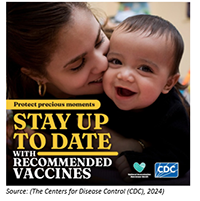 While most people think of infant vaccinations, there are routine vaccines for all ages. Guidance on useful vaccines continues to evolve, especially as viruses change or as new scientific developments create opportunities for new ways to help humans fight viruses, infections, or diseases. For example, the respiratory syncytial virus (RSV) vaccine helps infants and people over 60 fight off this cold-like virus, and the vaccine only became available in 2023, though the virus has been impacting the country since the 1950s (Robinson, 2023). The RSV vaccine is now a common offering for infants, people over 60, and immunocompromised people.
While most people think of infant vaccinations, there are routine vaccines for all ages. Guidance on useful vaccines continues to evolve, especially as viruses change or as new scientific developments create opportunities for new ways to help humans fight viruses, infections, or diseases. For example, the respiratory syncytial virus (RSV) vaccine helps infants and people over 60 fight off this cold-like virus, and the vaccine only became available in 2023, though the virus has been impacting the country since the 1950s (Robinson, 2023). The RSV vaccine is now a common offering for infants, people over 60, and immunocompromised people.
What is an immunization, and what does it do?
Immunizations have been scientifically shown to reduce or eradicate specific viruses or bacteria, improving the lives of many across the world. Illnesses like measles (caused by the measles virus) and recently, chickenpox (caused by the varicella zoster virus) can be combated easily by vaccines; not only does this reduce the misery of having sick children, but it also benefits the population as a whole – immunocompromised people whose bodies cannot fight infections or viruses as easily, and may be much more seriously impacted. As well, some viruses have greater implications than just a single illness; varicella zoster remains dormant in the body and can reemerge as the illness shingles (herpes zoster), more commonly seen in older adults (The Centers for Disease Control (CDC), 2024). The human papillomavirus (HPV) vaccine given to adolescents (and now, some adults) can prevent certain pre-cancers and cancer-causing infections, and has already reduced related infections by 88% among teen girls (The Centers for Disease Control (CDC), 2023). By participating in routine immunizations, people greatly increase their chances of avoiding illnesses and further complications from those illnesses.
Infants – age 19 to 35 months
People begin their vaccination schedule at birth, with the Hepatitis B vaccine series (The Centers for Disease Control (CDC), 2023). In North Dakota, this vaccine makes up one part of the 4:3:1:3:3:1:4 series recommended for infants. This series encompasses seven vaccinations to protect infants against diphtheria, tetanus and acellular pertussis (DTaP); polio; measles, mumps, and rubella (MMR); hepatitis B; haemophilus influenzae type B (Hib); varicella; and pneumococcal conjugate (PCV) and refers to the number of doses for each type of the vaccines. Coverage rates of this series have changed little over the past three years; with about two-thirds of infants (age 19 to 35 months) in the state completing the immunization program (Figure 1).
Figure 1 : Coverage Rate of Infant 4:3:1:3:3:1:4 Series in North Dakota, 2020 to 2023
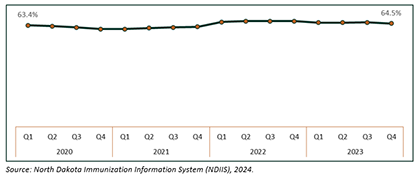
In the state overall, rotavirus and hepatitis A vaccines have the lowest coverage rates among infants (age 19 to 35 months). Rotavirus immunization can protect against highly contagious gastrointestinal illness, reducing the severity of the illness and even protecting entirely against it (The Centers for Disease Control (CDC), 2021). The rotavirus coverage rate, at just over 60% at the start of tracking in 2020, dipped to just over 50% at the end of 2023 (Figure 2). The hepatitis B immunization had the highest coverage rate at the end of 2023 (83%), followed closely by the polio vaccine (82%) and MMR (measles, mumps, and rubella; 80%).
Figure 2: Coverage Rate of Other Infant Immunization Series, North Dakota, 2020 to 2023
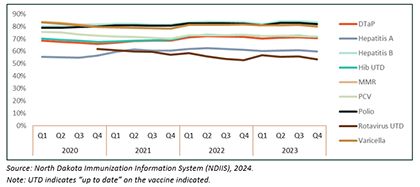
Adolescents – age 13 to 18 years
While there are a few immunizations that require boosters in adolescence and adulthood, such as varicella and TDaP (tetanus, diphtheria, and acellar pertussis), adolescents may now also undertake immunization series for meningococcal meningitis – both the ACWY conjugate (MCV4) and the B conjugate (MenB) - and human papillomavirus (HPV). These three vaccination series help protect pre-teens and teens from very serious illnesses, both in their teens and throughout later life. The varicella immunization has retained the highest rate of coverage among North Dakota adolescents (age 13 to 19), though TDaP and MCV4 (dose 1) are very close; 91% of adolescents received the varicella immunization at the end of 2023, while 88% received the first dose of the MCV4 series, and a similar proportion received their TDaP immunization (Figure 3).
Figure 3: Coverage Rate of Adolescent Immunization Series, North Dakota, 2020 to 2023
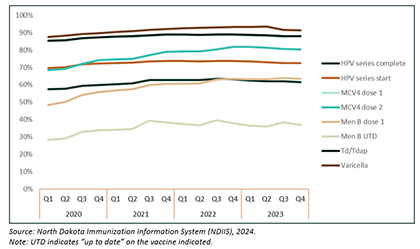
In North Dakota, less than 40% of adolescents are up to date (UTD) with their MenB vaccine. It is important to complete the series with immunizations that require more than one dose; many vaccines are not effective without the full series of doses.
Adults – 19 years and over
Adults have the fewest immunizations to maintain or start; however, recently two new vaccines have been added. One is for respiratory syncytial virus (RSV), and the other is a two-dose series for shingles.
In North Dakota, the Shingrix vaccine is offered for adults over 50 to help prevent the emergence of shingles. Since 2021, there has been an increasing rate of uptake in the state, with 42% of adults over 50 in the state having received one dose by the end of the first quarter of 2024 (Figure 4).
Figure 4: Coverage Rate of Adult Immunization Series, North Dakota, 2020 to Q1 2024
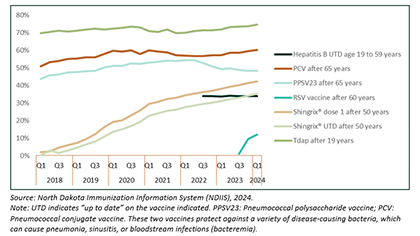
With just two quarters of tracked data, trend is difficult to determine, but the RSV vaccine coverage rate has increased sharply since its first tracked date in Q3 2023, from one percent in that quarter to 12% in Q1 2024.
When should you get an immunization?
Most immunizations are on a schedule, especially for infants and adolescents. If you have had children, your health care provider has probably discussed with you the detailed plan for immunization visits. As we age, it becomes less clear when we should receive our immunizations; however, there are three general times to visit your health care provider for vaccines: before cold and flu season, during pregnancy, and before international travel (1).
Since the COVID-19 pandemic, immunizations and boosters for COVID-19 and influenza have been commonly administered in the fall, before these viruses generally increase in prevalence. Colder months drive humans indoors, where viruses are easier to spread and harder to avoid; getting immunized prior to winter helps limit the severity and duration of viruses.
Coverage for the influenza immunization was at its peak for most age groups in the 2020-21 season, and has declined across the years with the exception of those age 65 and older, who have retained a coverage rate just below 60% for the last four years (Figure 5).
Figure 5: Influenza Immunization Coverage Rates, All Age Groups, North Dakota, 2020 to 2024
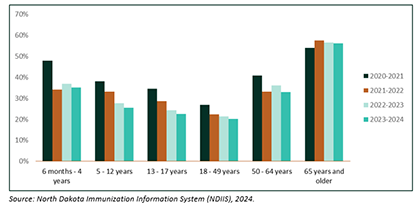
Immunizations are often offered to pregnant women during stages of pregnancy to protect both mothers, who are immunocompromised during pregnancy, and may be more susceptible to viruses and bacteria, and babies, who can benefit from vaccines while in utero (The Centers for Disease Control (CDC), 2024). In the 12 months before delivery, 66% of pregnant women in North Dakota received an influenza vaccination in 2021; this is a distinct drop from the peak coverage of 74% in 2020 (Figure 6).
Figure 6: Influenza Vaccine Coverage for Pregnant Women, North Dakota, 2017 to 2021
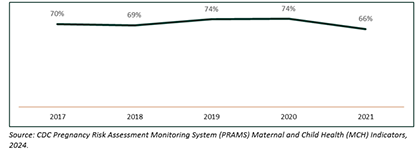
Where to go for more information
Health care providers are the best source of information on immunizations. Your primary care provider, a public health worker, or telehealth responder can help give you information, book an appointment, or address concerns you may have. As well, if you’re looking for more information on immunizations for your children or adolescents, you can check the CDC’s information for parents; they have detailed pages on vaccines for people at any age, including adults. Keeping your immunizations up to date is a good way to help prevent severe, prolonged illnesses, and to minimize symptoms if you do get sick.
(1)The CDC offers an extensive portal on travelers’ health, including advisories and FAQs for people going abroad. This can help you prepare for any travel you may be undertaking. You can find more information here: https://wwwnc.cdc.gov/travel/page/traveler-information-center or at the North Dakota Health and Human Services travel portal here, which can also help you find local travel vaccination clinics: https://www.hhs.nd.gov/health/diseases-conditions-and-immunization/immunizations/travel
References
Robinson, S. (2023, September). Respiratory Syncytial Virus (RSV) is making the headlines. Retrieved from University of Texas Medical Branch at Galveston: https://www.utmb.edu/pedi/news/news-article-page/2023/09/26/rsv-awareness#:~:text=RSV%20was%20first%20identified%20by,be%20primarily%
20a%20human%20virus.
The Centers for Disease Control (CDC). (2021, March 25). Rotavirus Vaccination: What Everyone Should Know. Retrieved July 19, 2024, from Vaccines and Preventable Diseases: https://www.cdc.gov/vaccines/vpd/rotavirus/public/index.html
The Centers for Disease Control (CDC). (2023, November 16). Child and Adolescent Immunication Schedule by Age (Addendum updated June 27, 2024). Retrieved July 19, 2024, from Immunization Schedules: https://www.cdc.gov/vaccines/schedules/hcp/imz/child-adolescent.html
The Centers for Disease Control (CDC). (2023, August 16). HPV Vaccine. Retrieved July 17, 2024, from Human Papillomavirus (HPV): https://www.cdc.gov/hpv/parents/vaccine-for-hpv.html
The Centers for Disease Control (CDC). (2024, April 24). About Chickenpox. Retrieved July 19, 2024, from Chickenpox (Varicella): https://www.cdc.gov/chickenpox/about/index.html
The Centers for Disease Control (CDC). (2024, June 17). About Vaccines and Pregnancy. Retrieved July 19, 2024, from Pregnancy and Vaccination: https://www.cdc.gov/vaccines-pregnancy/about/index.html
The Centers for Disease Control (CDC). (2024, July 9). National Immunization Awareness Month (NIAM). Retrieved from Calendar and Events: https://www.cdc.gov/vaccines/events/niam/index.html
